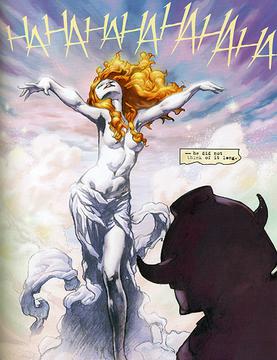Odd means unpaired, occasional, strange or unusual, or a person who is viewed as eccentric.
Frosting or Frosted may refer to:
In Norse mythology, Élivágar are rivers that existed in Ginnungagap at the beginning of the world. The Prose Edda relates:
The streams called Ice-waves, those which were so long come from the fountain-heads that the yeasty atter upon them had hardened like the slag that runs out of the fire,-these then became ice; and when the ice halted and ceased to run, then it froze over above. But the drizzling rain that rose from the venom congealed to rime, and the rime increased, frost over frost, each over the other, even into Ginnungagap, the Yawning Void. Gylfaginning 5.
Sir David Frost (1939–2013) was a British broadcaster.

"The Frost-Giant's Daughter" is one of the original fantasy short stories about Conan the Cimmerian, written by American author Robert E. Howard.
Frost may refer to two distinct weather phenomena:

Against the Giants is an adventure module written by Gary Gygax and published by TSR in 1981 for the Dungeons & Dragons fantasy role-playing game. It combines the G series of modules previously published in 1978: Steading of the Hill Giant Chief, Glacial Rift of the Frost Giant Jarl, and Hall of the Fire Giant King. All three were produced for use with the 1st edition Advanced Dungeons & Dragons rules. In 1999, to recognize the 25th anniversary of TSR, the company released an updated version, Against the Giants: The Liberation of Geoff. Later in 1999, Wizards of the Coast published a novelization of Against the Giants by Ru Emerson.

Ymir is a character appearing in American comic books published by Marvel Comics. Created by Stan Lee and Jack Kirby, the character first appeared in Journey into Mystery #97. Ymir is based on the frost giant of the same name from Norse mythology. Ymir is a recurring antagonist of the superhero Thor.
In astronomy or planetary science, the frost line, also known as the snow line or ice line, is the minimum distance from the central protostar of a solar nebula where the temperature is low enough for volatile compounds such as water, ammonia, methane, carbon dioxide and carbon monoxide to condense into solid grains, which will allow their accretion into planetesimals. Beyond the line, otherwise gaseous compounds can be quite easily condensed to allow formation of gas and ice giants; while within it, only heavier compounds can be accreted to form the typically much smaller rocky planets.
In geology, the frost line is the level down to which the soil will normally freeze each winter. By an analogy, the term is introduced in other areas.
Ryan Murphy may refer to:

In the Dungeons & Dragons fantasy role-playing game, giants are a collection of very large humanoid creatures based on giants of legend, or in third edition, a "creature type".

Jack Frost is a fictional superhero appearing in American comic books published by Marvel Comics. The character first appeared in 1941 in U.S.A. Comics published by Marvel's 1940s forerunner Timely Comics, during the period fans and historians call the Golden Age of comic books.
Frost is a surname. Notable people with the surname include:

Laufey is a supervillain appearing in American comic books published by Marvel Comics. The character is depicted usually as an enemy of the Asgardian king Odin, father of Thor. He is the King of the Frost Giants, the biological father of Thor's adopted brother and archenemy, Loki. Created by writer Stan Lee and artist Jack Kirby, he first appeared in Journey into Mystery #112, and was based on the goddess of the same name.

Copernicus is a large crater on Mars, with a diameter close to 300 km. It is located south of the planet's equator in the heavily cratered highlands of Terra Sirenum in the Phaethontis quadrangle at 48.8°S and 191.2°E. Its name was approved in 1973, and it was named after Nicolaus Copernicus.
Frost giant is a common, but controversial, gloss for a type of jötunn, a being in Germanic folklore and mythology.
This page is based on this
Wikipedia article Text is available under the
CC BY-SA 4.0 license; additional terms may apply.
Images, videos and audio are available under their respective licenses.






